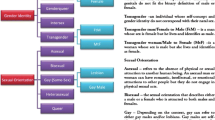Abstract
In her popular book on gender differences in communication, Deborah Tannen proposed that women and men interpret messages along different dimensions (intimacy and control) and that these differing interpretations make intersex communication difficult. In the present study, we contrasted Tannen's model with a more complex model that incorporated gender role as a factor that influences the interpretations of messages. Causal modeling of data from questionnaires (N = 192) administered to predominately European American university students revealed stronger support for a complex model than for the basic model.
Similar content being viewed by others
references
Alexander, C. S., & Becker, H. J. (1978). The use of vignettes in survey research. Public Opinion Quarterly, 42, 83-104.
Bem, S. L. (1974). The measurement of psychological androgyny. Journal of Consulting and Clinical Psychology, 42, 155-162.
Broverman, I. K., Vogel, S. R., Broverman, D. M., Clarkson, F. E., & Rosenkrantz, P. S. (1972). Sex-role stereotypes: A current appraisal. Journal of Social Issues, 28, 59-78.
Burgoon, J. K., & Hale, J. L. (1987). Validation and measurement of the fundamental themes of relational communication. Communication Monographs, 54, 19-41.
Copello, A. G., & Tata, P. R. (1990). Violent behaviour and interpretive bias: An experimental study of the resolution of ambiguity in violent offenders. British Journal of Clinical Psychology, 29, 417-428.
Duck, S., & Barnes, M. K. (1992). Disagreeing about agreement: Reconciling differences about similarity. Communication Monographs, 59, 199-208.
Eagly, A. H. (1987). Sex differences in social behavior: A social-role interpretation. Hillsdale, NJ: Erlbaum.
Eagly, A. H., & Steffen, V. J. (1984). Gender stereotypes stem from the distribution of women and men into social roles. Journal of Personality and Social Psychology, 46, 735-754.
Edwards, R. (1998). The effects of gender, gender role, and values on the interpretation of messages. Journal of Language and Social Psychology, 17, 52-71.
Edwards, R., & Bello, R. (2001). Interpretations of messages: The influence of equivocation, face concerns, and ego involvement. Human Communication Research, 27, 597-631.
Edwards, R., Bello, R., Brandau-Brown, F., & Hollems, D. (2001). The effects of loneliness and verbal aggressiveness on message interpretation. Southern Communication Journal, 66, 139-150.
Garlick, R. (1994). Male and female responses to ambiguous instructor behaviors. Sex Roles, 30, 135-158.
Gianakos, I. (2000). Gender roles and coping with work stress. Sex Roles, 42, 1059-1079.
Goldsmith, D. J., & Fulfs, P. A. (1999). “You just don't have the evidence”: An analysis of claims and evidence in Deborah Tannen's You just don't understand. In M. E. Roloff (Ed.), Communication yearbook 22 (pp. 1-49). Thousand Oaks, CA: Sage.
Gray, J. (1992). Men are from Mars, women are from Venus. New York: HarperCollins.
Green, B. L., & Kenrick, D. T. (1994). The attractiveness of gender-typed traits at different relationship levels: Androgynous characteristics may be desirable after all. Personality and Social Psychology Bulletin, 20, 244-253.
Hunter, J. E., & Hamilton, M. A. (1998). Meta-analysis of controlled message designs. In M. Allen & R. W. Priess (Eds.), Persuasion: Advances through meta-analysis (pp. 29-52). Creskill, NJ: Hampton Press.
Hunter, J. E., Hamilton, M. A., & Allen, M. (1989). The design and analysis of language experiments. Communication Monographs, 56, 341-363.
Jones, D. C., Bloys, N., & Wood, M. (1990). Sex roles and friendship patterns. Sex Roles, 23, 133-145.
Maltz, D. N., & Borker, R. A. (1982). A cultural approach to male–female miscommunication. In J. J. Gumperz (Ed.), Language and social identity (pp. 196-216). Cambridge UK: Cambridge University Press.
Metts, S., Cupach, W. R., & Imahori, T. T. (1992). Perceptions of sexual compliance-resisting messages in three types of cross-sex relationships. Western Journal of Communication, 56, 1-17.
Meyers, R. A., Brashers, D. E., Winston, L., & Grob, L. (1997). Sex differences and group argument: A theoretical framework and empirical investigation. Communication Studies, 48, 19-41.
Michaud, S. L., & Warner, R. M. (1997). Gender differences in self-reported response in troubles talk. Sex Roles, 37, 527-540.
Michel, K. (1994). Conversation on-line: Girls' rapport talk and boys' report talk. Women and Language, 17, 30-35.
Motley, M. T., & Reeder, H. M. (1995). Unwanted escalation of sexual intimacy: Male and female perceptions of connotations and relational consequences of resistance messages. Communication Monographs, 62, 355-382.
Noller, P. (1993). Gender and emotional communication in marriage: Different cultures or differential social power? Journal of Language and Social Psychology, 12, 132-152.
Peterson, C. D., Baucom, D. H., Elliott, M. J., & Farr, P. A. (1989). The relationship between sex role identity and marital adjustment. Sex Roles, 21, 775-787.
Ramanaiah, N. V., & Detwiler, F. R. (1992). Psychological androgyny and the NEO personality inventory. Psychological Reports, 71, 1216-1218.
Ramanaiah, N. V., Detwiler, F. R., & Byravan, A. (1995). Sex-role orientation and satisfaction with life. Psychological Reports, 77, 1260-1262.
Robinson, M. D., & Clore, G. L. (2001). Simulation, scenarios, and emotional appraisal: Testing the convergence of real and imagined reactions to emotional stimuli. Personality and Social Psychologyy Bulletin, 27, 1520-1532.
Shifren, K., & Bauserman, R. L. (1996). The relationship between instrumental and expressive traits, health behaviors, and perceived physical health. Sex Roles, 34, 841-864.
Tannen, D. (1990). You just don't understand: Women and men in conversation. New York: Morrow.
Tannen, D. (1994). Gender and discourse. New York: Oxford University Press.
Uleman, J. S., & Weston, M. (1986). Does the BSRI inventory sex roles? Sex Roles, 15, 43-62.
Author information
Authors and Affiliations
Corresponding author
Rights and permissions
About this article
Cite this article
Edwards, R., Hamilton, M.A. You Need to Understand My Gender Role: An Empirical Test of Tannen's Model of Gender and Communication. Sex Roles 50, 491–504 (2004). https://doi.org/10.1023/B:SERS.0000023069.93583.8b
Issue Date:
DOI: https://doi.org/10.1023/B:SERS.0000023069.93583.8b




